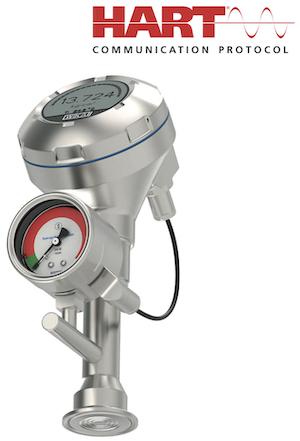
Self-monitoring digital instruments are essential to the safe operation of Industry 4.0 manufacturing. The next generation of WIKA’s diaphragm seal system offers foolproof monitoring with HART® communication protocol, ideal for sanitary processes in the pharmaceutical industry.
Diaphragm seal systems are the go-to pressure-measuring instruments for the pharmaceutical & biotechnology and food & beverage industries. This is because the clean media never comes into contact with the internal mechanisms of the gauge, thanks to the thin diaphragm that flexes to transmit pressure. Indeed, diaphragm seals offer an extremely safe and sanitary way to measure pressure.
However, there is one drawback for hygienic processes: the transmission fluid. Even if the system fill fluid is FDA approved and USP (US Pharmacopeia) compliant, a tiny leak will ruin the entire batch.
How Product Contamination Led WIKA to Develop Our Diaphragm Monitoring System
After vaccine manufacturers make an active pharmaceutical ingredient (API), they put the finished product in mobile tanks and ship it to facilities that fill the injection vials. Diaphragm seal systems monitor the internal pressure of the tanks, which are rigorously sterilized to ensure product purity.
Diaphragm seals are built to withstand the strong chemicals and sprays of routine sterilizing, but they are not indestructible. Even if the diaphragm seal system suffers just minor damage, transmission fluid will leak into the filled tank and ruin that batch of API.
This is what happened to one vaccine company. After the second of such contamination incidents, each of which cost them millions in lost time and products, they looked for a better pressure measurement solution.
Against this backdrop, WIKA engineers came up with our patented diaphragm seal system with diaphragm monitoring. It has two seals: a primary one that comes into direct contact with the media, and a secondary one that serves as a backup. In between is a vacuum that is monitored by our PGS23.063 pressure gauge with switch contact. If the vacuum is ever breached, this gauge immediately sends out a warning. Meanwhile, the intact secondary seal allows the UPT-20 process transmitter to continue monitoring process pressure – and separate the transmission fluid from the sanitary media – until the instrument can be repaired.
WIKA Builds a Diaphragm Monitoring System for Industry 4.0
Our original model had two separate measuring components: one instrument for monitoring the process media’s pressure, and another instrument that monitored the vacuum. These two elements operated independently of each other and had their own signal outputs.
When manufacturers started incorporating IIot (Industrial Internet of Things) into their facilities, WIKA engineers knew it was time to develop the next generation of our proven monitoring solution.
Model DMSU21SA is a diaphragm monitoring system with HART® communication protocol, allowing for easy integration into an existing HART® environment. This state-of-the-art instrument is an integrated system, transmitting data on process pressure, diaphragm status, and process temperature via one cable. There is no need to lay a second cable harness.
Operators onsite can also easily see the process pressure on the transmitter’s display, which refreshes every 0.2 seconds. On the monitoring element, if the pointer is in the green range, the outer diaphragm is intact. If it’s in the red range, the outer diaphragm is defective and must be replaced. The status changes from green to red only if the specified set point lasts longer than 1.5 seconds; this is so that shocks or vibrations do not unintentionally trigger the alarm.
Our patented double-diaphragm system is flexible, with options for different electrical connections and all the common process connections for sanitary applications:
- Clamp connection per DIN 32676
- Clamp connection per ISO 2852
- Aseptic threaded pipe connection per DIN 11864-1
- Aseptic flange connection per DIN 11864-2
- Aseptic clamp connection per DIN 11864-3
- Ingold connection with union nut
The DMSU21SA comes standard with EHEDG approval for hygienic equipment design, with options for many other conformities. Consumers have options for the case material; for hygienic industries, we recommend a stainless steel case head with electropolished surfaces for even greater cleanability and corrosion resistance.
Although this next-generation diaphragm monitoring system is designed for use in IIoT manufacturing, it is equally suitable for analog plants. HART® is based on a 4…20 mA output signal, so without this communication protocol, the DMSU21SA will simply transmit data – process pressure, diaphragm status, and process temperature – using a residual current. And when the analog facility is ready for Industry 4.0 connectivity, it will already have the advanced instruments in place.
Diaphragm Monitoring System Offers Cost Savings, Extra Peace of Mind
WIKA’s innovative pressure solution provides detailed data for informed decision-making. If the system warns of a rupture, operators know exactly when the diaphragm breach occurred and then can take the appropriate action, such as stopping the process, closing the feed valve, or diverting the batch into another tank. They can rest assured that the product in the tank remains uncontaminated, thanks to the backup diaphragm seal.
Some manufacturers cannot afford even the slightest risk of contamination, in the extremely small chance that the secondary diaphragm had undetected damage. In that case, at least the amount wasted can be kept to a minimum. Without a monitoring element that records the exact second when the process-side diaphragm was damaged, users would have to go back to the last maintenance service and destroy every batch that occurred after that – just to rule out every conceivable risk. The financial loss in such instances can easily run into the millions.
WIKA USA, a Trusted Partner for the Pharmaceutical Industry
Sanitary processes have no tolerance for risk. That is why WIKA’s diaphragm seal systems with diaphragm monitoring are found on pharmaceutical fermenters, bioreactors, vessels, and mobile tanks in plants around the world. And as more companies adopt IIoT in manufacturing, they are incorporating self-monitoring instruments into their processes. For more information on the DMSU21SA or other measuring instruments for sanitary applications, contact WIKA USA.


